Not many vehicles produced for mass consumption have garnered the same level of recognition across the globe as the Ford Mustang. The initial model, which made its debut at the New York World Fair on April 17, 1964, had a significant impact on the automobile industry in the United States by popularizing the Pony Car concept.
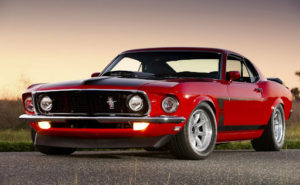
In the early 1960s, market research indicated a growing interest in compact sports vehicles in the United States. However, the failure of the Edsel model made Ford’s CEO Henry Ford II doubt the validity of this research. At that time, success for Ford was not only desirable but also crucial, as another failure similar to the Edsel model could have resulted in bankruptcy for the company. Despite these concerns, former Ford President and Mustang co-creator Lee Iacocca took it upon himself to develop the model. The automobile exceeded expectations, with 22,000 automobiles sold on the first day of its loud presentation in March 1964 and over 250,000 automobiles sold by the end of the year.
From the first sketch to the legendary design
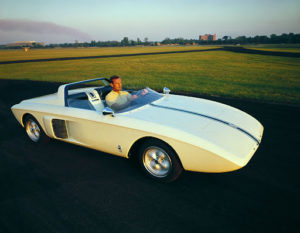
Interestingly, the prototype of the now legendary model had a very different appearance. It was created in 1962 and had a futuristic design for its time. Iacocca approved the initial design, which included oval headlights following European automotive design standards. However, legal restrictions required the headlights to be changed to round ones. To reduce costs, the taillights were designed as three separate sections instead of a single unit, and this iconic aspect of the automobile was eventually copied by many other car manufacturers. The final model was named Cougar and was presented to Henry Ford II for approval. According to Iacocca’s memoirs, Henry liked the Cougar but didn’t give it his approval, with the comment “Do not even think of stopping.” Despite this, several modifications were made to the design, and the automobile was ultimately approved for production.
A delicate question of how Torino was banned
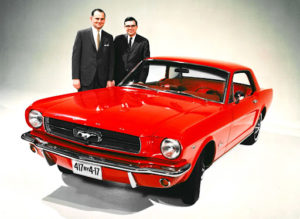
According to Lee Iacocca, at a meeting to discuss product strategy in May, there were four potential names for a car: Monte Carlo, Monaco, Torino, and Cougar. Ultimately, the team settled on Torino. Iacocca noted that choosing a name for an automobile was a challenging task, as they knew it had a significant impact on the success of a new model and could sometimes be more difficult to decide than designing the car itself. In the case of the Mustang, the situation was even more dramatic. The iconic name was chosen just before the automobile’s release.
Due to Henry Ford’s romantic affair with an Italian woman, the team decided to abandon it to avoid any negative reactions or rumors. A naming expert, John Conley, went to the Detroit Public Library to find a suitable name. Out of the thousands of options he brought back, the team narrowed it down to six: Bronkow, Puma, Cheetah, Colt, Mustang, and Cougar. In the end, they selected Mustang as it conveyed a sense of adventure and had a truly American feel. Iacocca wrote about this in his autobiography, “A Manager’s Career.”
Dizzying success
The birth of the legend was an event to remember, as it first hit the roads on March 9, 1964. Not long after, a sensational marketing campaign was launched, and by the end of that same year, an incredible 263,434 automobiles had been sold.
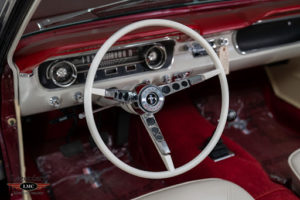
There’s a theory that the model’s designers were influenced by the Continental Mark II when creating its body, although it’s hard to see any real similarities between the two. The only noticeable connection could be the proportion of a long hood and a short trunk, but even that is debatable. What’s interesting is that the team behind the Mustang wasn’t sure it would be a success during the development stage.
It was different from the typical American cars with fewer chrome elements and lacked the shine that was common among American vehicles at the time. Its technical specifications were nothing special either. The engine, for example, was just taken from the Ford Falcon, a six-cylinder that was increased to 2.8 liters. The gearbox was either a three-speed manual or a two and three-speed variator. The front suspension and anti-roll bar was also borrowed from the Falcon. The basic modification came equipped with drum brakes, which could be upgraded with a vacuum booster.
The steering mechanism was straightforward, using a worm gear and circulating balls taken from the Falcon, and power steering was a rare feature at the time. The inside of the automobile was just as impressive as the outside. The front seats had separate adjustments and could be folded for easy access to the back. The rear seat backrest could be folded down to increase the luggage space. Buyers had a choice of several dozen options, including air conditioning, a center floor console, various audio systems, a clock, a tachometer on the steering column, a solid front seat, and an automatic transmission. The most budget-friendly version of the 1964 release came with a 2.8-liter Thriftpower inline-six engine, completed with a carburetor and 106 horsepower.
Epilog
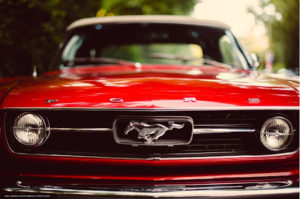
Throughout the years, the “American stallion” had undergone several changes and upgrades, resulting in six distinct generations. Each new iteration boasted new design aspects, improved performance, and cutting-edge technology. The iconic classic look of the first generation had evolved into a sleeker, more aerodynamic design in later models, all while maintaining the Mustang’s unique character.
The impact of this timeless classic is undeniable, with its mark felt in both the automotive world and popular culture. This glorious “stallion” made countless appearances in movies, TV shows, and video games, cementing its place as one of the most recognizable and beloved cars of all time. With its powerful engine, iconic design, and passionate following, the Mustang will forever be remembered as a true automotive legend.
If you like this article, please share it with your friends.

